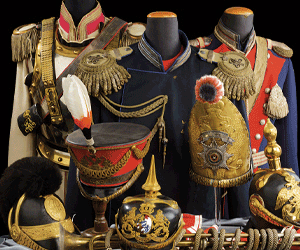NSKK Greatcoat
SKU: 53.GOR.02.01.02.001
Estimated market value:



Estimated market value:
Attributes
History
The NSKK (Nationalsozialistisches Kraftfahr-Korps = National Socialist Motor Corps) was a paramilitary organisation affiliated with the NSDAP, specialising in anything related to the driving of motorised vehicles. NSDAP officials recognised the need for access to cars and trucks for both transportation and propaganda purposes as early as 1922, and certain steps were taken to ensure this need was met. However, it took until April of 1930 for a specialised motor organisation to be officially founded. This organisation was named NSAK (Nationalsozialistisches Automobil-Korps = National Socialist Automobile Corps), but was renamed to NSKK less than 13 months later.
Initially, the NSAK/NSKK was under the control of the SA and existed next to its parent organisation’s own driving-related sub-organisation, the Motor-SA. This changed after the “Night of the Long Knives”, in which many SA leaders were purged and the organisation was substantially disempowered. After July of 1934, the NSKK became an independent organisation whose leader, NSKK-Korpsführer Adolf Hühnlein, answered directly to Adolf Hitler.
The main tasks of the NSKK were to provide transportation for all organisations of the Third Reich, to train and instruct boys and men (and a number of women) in mechanics and driving, and to assist police in regulating traffic. During the mid 1930s, the organisation also provided roadside assistance.
With the onset of the war, the NSKK’s tasks underwent certain changes. Instructing both civilians and soldiers in the driving and maintenance of armored vehicles became a higher priority. The NSKK also began working closely with other organisations, for example Organisation Todt (OT), by providing transportation of workers and supplies for the colossal building project that was the fortification of Germany’s Western border, the Siegfried Line (or Westwall). During the war, the NSKK provided much of the transportation needs for the German Army and the Luftwaffe, including the transport of troops, weapons and ammunition, and building materials, for example for the construction of air bases in the newly conquered territories in Eastern Europe after the attack on Soviet Russia in the summer of 1941.
Parts of the NSKK would come under the control of architect Albert Speer who took over OT after the death of Fritz Todt in 1942, leading to the creation of Transport Brigade Speer (later Transport Corps Speer), which would eventually completely sever its ties to the NSKK.
Members of the NSKK were originally issued regulation Sturmabteilung (SA) greatcoats, but eventually, an olive-green version with a dark brown collar was produced for the NSKK. The greatcoat has two rows of six silver buttons and it closes on the right side. The coat features a flapped pocket on each hip, as well as turn-back cuffs.
The reverse of the coat features a half-belt with two buttons and a vent with an inverted pleat. The vertical seam and box pleat allow the coat to expand and accommodate the wearer’s uniform underneath.
Officer ranks wore greatcoats with twisted aluminium piping around the collar, while Enlisted Men (EMs) wore greatcoats that did not have piping around the collars. Personnel with the rank of Oberfüher and above were allowed to wear the top three buttons of the coat open, with the lapels folded back to expose the dark brown interior lining.
In the pre-war years, NSKK personnel wore cross straps over the coat, and they were later permitted to wear a belt without a cross strap. The greatcoat was originally worn with the NSDAP armband, but after 1939, the armband was replaced with the NSKK national emblem. In addition, the coat was also worn with the driver's badge and at times, a dagger was suspended from the left hip.
Officers were allowed to wear a rubberised version of the greatcoat in inclement weather.
Members of the NSKK motorboat units wore a Navy-style dark blue greatcoat with gilt buttons featuring an embossed fouled anchor.

Versions
$500 USD
$325 USD


Comments
Sign in to comment and reply.


Scroll Top